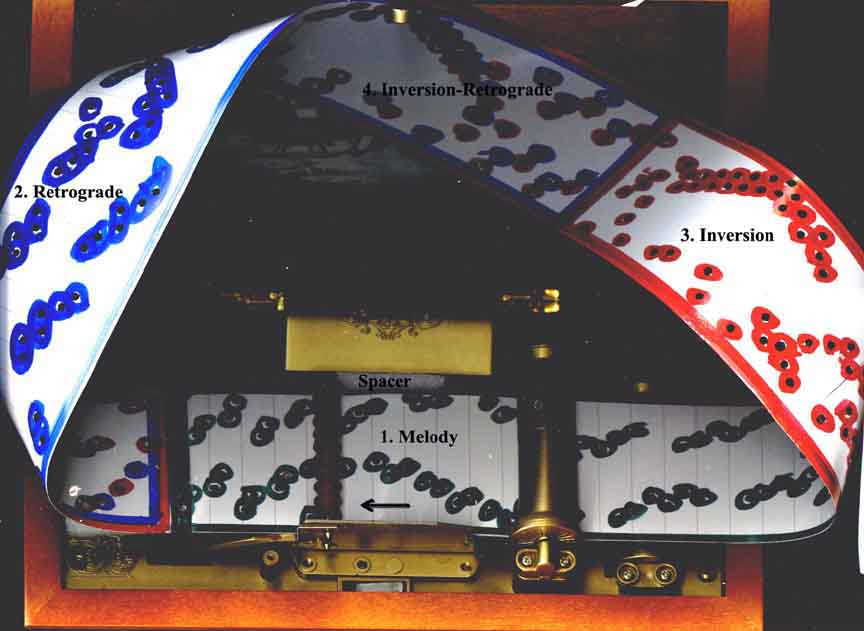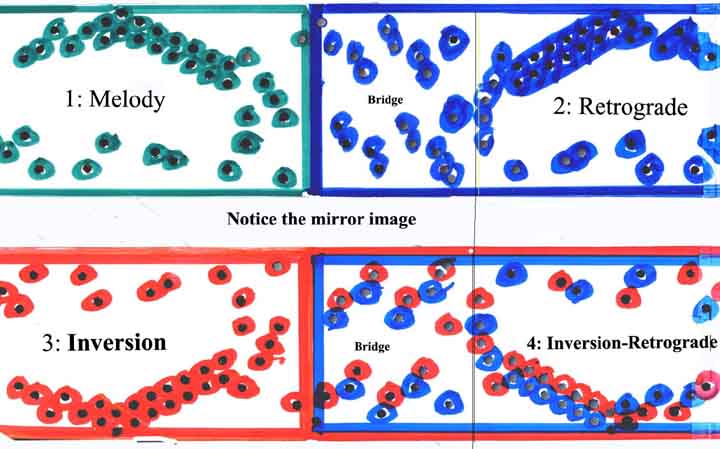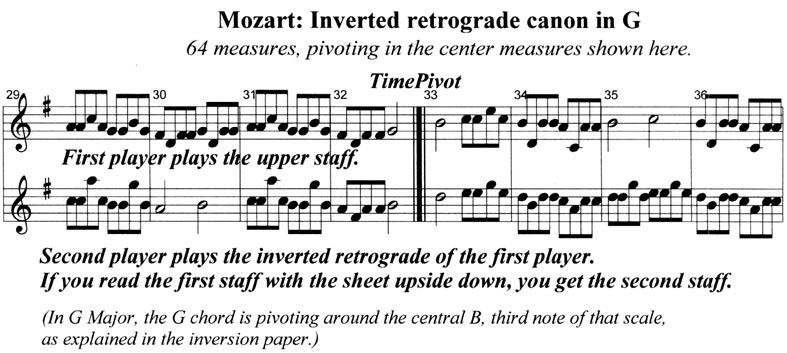| You Are Not Logged In | Login/Get New Account |
|
Please Log In. Accounts are free!
Logged In users are granted additional features including a more current version of the Archives and a simplified process for submitting articles. |
|
MMD
 Sounds
Sounds
 Sankyo20
Sankyo20
 tremblay2
tremblay2
|
|
Spring Fundraising Drive In Progress. Please visit our home page to see this and other announcements:
https://www.mmdigest.com Thank you. --Jody
|
|
Playing "retrograde" with Sankyo 20-note musical box and possibly other instruments. by Roland Tremblay (030228 MMDigest)
Remember what inverse playing means? Look at the article, with pictures and MIDI files, in the MMD Technical archives: "Inversus: Sankyo 20-Note Moebius Strip Plays Inverse Music". Now, what about retrograde playing? "Retrograde" means "walking backwards". The paper roll goes from the end to the beginning so the rhythm is reversed, but since the paper is upside down, the notes stay the same (treble to treble, bass to bass). Unlike inversion, retrograde is not affected by the scale and thus can be used on any instrument that accepts the roll backwards and upside down. Retrograding a MIDI file is easy with a sequencer that offers that function, like Cakewalk. You get the notes in reverse order. If you use an organ, the MIDI file is a clone of the punched roll. This musical trick was already used in the XIVth century. For the Smith 20-note organ scale, I loosely arranged a medieval composition by Machault, aptly entitled "My end is my beginning", 24 bars forwards, 24 backwards (MachoRet.mid). Retrograde music is a kind of palindrome -- a sentence that can be read backwards -- as in: "Madam, I'm Adam", or in the "Satanic" messages on Rock records. The William Tell Overture backwards is a musical palindrome! Since the tune needs fast repetition, let's try a glockenspiel register on the same 20-note scale. The Lone Ranger is galloping away, then coming back. Serendipity rarely generates masterpieces. :-) (WilRetGlok.mid) When MIDI files reproduce the various length of the notes, the holes of a retrograde strip will not reproduce exactly the reversed rhythm with an instrument that have equal length notes, like a glock or a music box. To compensate, I divide long notes into smaller units. I arranged for the Sankyo a Minuet and a Trio al Rovescio ("in Reverse") by F.J. Haydn. Each section is followed by its retrograde, so the strip plays the same music if you start it tail first and upside down. You can look at the mirrored pattern strip (HydnSten.jpg) as you listen to HaydnRet.mid Playing retrograde non-stop with a Sankyo strip is easy. Two identical choruses are taped together, but one moves backwards and is set upside down so all notes stay the same. Looped, that strip forms a flat belt, not a twisted Moebius band. Inverse-retrograde playing. I composed a tune compatible with both inverse and retrograde playing.
I then punched two identical strips and taped the second to the first one
in retrograde position (end first and upside down). Twist it 180
degrees, loop it, and Moebius rolls again! See InveRetro.jpg and
MirrorStrip.jpg
With only two punched choruses, we get a 5-part song ABCDA: (A) Melody; (B) Retrograde; -- Twist --(C) Inverse; (D) Inverse and Retrograde; --Twist-- (A) Melody. Hear it on InveRetro.mid Mozart even played both the melody and its inverse-retrograde simultaneously. Two players face each other across the same sheet. One plays the melody while the second plays the inverse-retrograde by reading the sheet upside down in opposite direction. Those inverse-retrograde canons wouldn't be as spectacular on mechanical instruments. The listener, unaware of the complexity of the composition, would perceive only a simple tune. Judge for yourself: MozDuet.mid (MozDMir.jpg shows some of the mirror notes. In 021231 MMDigest, Philippe Rouille also gave here a link to sheet music.)
Musical research confirms that an "inverse-retrograde" melody is not detected by casual listeners. It also finds that they more easily recognize an inverse melody than a retrograde one. For the Sankyo playing the inverse or inverse-retrograde variation, the Moebius strip is interesting to watch and economical to punch. For mechanical instruments without diatonic scale, retrograde is the only option. Roland Bruno Tremblay
tremblay2_HaydnRet.mid
28 February 2003 |
|
|
|
|
|
|
|
|
|
CONTACT FORM: Click HERE to write to the editor, or to post a message about Mechanical Musical Instruments to the MMD Unless otherwise noted, all opinions are those of the individual authors and may not represent those of the editors. Compilation copyright 1995-2024 by Jody Kravitz. Please read our Republication Policy before copying information from or creating links to this web site. Click HERE to contact the webmaster regarding problems with the website. |
|
|
||||||
|



